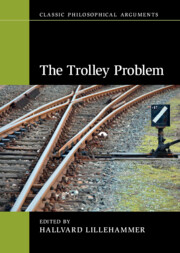Book contents
- The Trolley Problem
- Classic Philosophical Arguments
- The Trolley Problem
- Copyright page
- Contents
- Tables
- Contributors
- Acknowledgments
- Introduction
- 1 Keeping track of your trolleys
- 2 Shunted trolleys and other diversions
- 3 Must we turn the trolley?
- 4 Non-consequentialism in light of the trolley problem
- 5 Non-consequentialist principles under conditions of uncertainty
- 6 The trolley problem and the doing/allowing distinction
- 7 Virtue ethics and the trolley problem
- 8 Trolley dilemmas from the philosopher’s armchair to the psychologist’s lab
- 9 Trolleyology
- 10 Cross-cultural responses to trolley problems and their implications for moral philosophy or
- 11 Ethical accident algorithms for autonomous vehicles and the trolley problem
- 12 A new trolley problem?
- Bibliography
- Index
2 - Shunted trolleys and other diversions
Solving Thomson’s puzzles
Published online by Cambridge University Press: 24 February 2023
- The Trolley Problem
- Classic Philosophical Arguments
- The Trolley Problem
- Copyright page
- Contents
- Tables
- Contributors
- Acknowledgments
- Introduction
- 1 Keeping track of your trolleys
- 2 Shunted trolleys and other diversions
- 3 Must we turn the trolley?
- 4 Non-consequentialism in light of the trolley problem
- 5 Non-consequentialist principles under conditions of uncertainty
- 6 The trolley problem and the doing/allowing distinction
- 7 Virtue ethics and the trolley problem
- 8 Trolley dilemmas from the philosopher’s armchair to the psychologist’s lab
- 9 Trolleyology
- 10 Cross-cultural responses to trolley problems and their implications for moral philosophy or
- 11 Ethical accident algorithms for autonomous vehicles and the trolley problem
- 12 A new trolley problem?
- Bibliography
- Index
Summary
Philippa Foot offered her original Trolley Case, where a driver will unavoidably kill either five or one, neither to present a moral quandary nor to pose any special problem for moral theory. Its purpose was simply to illustrate how her theory of duties – which she deployed to defend non-consequentialist intuitions about various other cases of harmful agency – could also handle cases like this one where consequentialist verdicts seem apt. The Trolley Problem arose when Judith Jarvis Thomson modified the case, using the bystander variation to raise difficulties for Foot. Intuitively, it seems that the bystander may equally turn the trolley, but that would amount to killing one to save five, which was ruled out by Foot’s theory (even though it allowed a driver to kill one to avoid killing five). That was the Trolley Problem, which amounted to a challenge to explain why the bystander trolley case is an exception to the usual prohibition against killing some to save others for the greater good. For decades Thomson saw it as a legitimate challenge and offered plausible ways of meeting it. Later, however, she changed her mind, concluding that it is not permissible for the bystander to turn the trolley after all. In this chapter, I begin by examining the relevant background, refining the understanding of the Trolley Problem, and considering basic methodological issues in this area of normative ethics. I then develop a solution to the Trolley Problem along with a diagnosis of what went wrong in Thomson’s later attempt to show that there was never really a Trolley Problem to begin with. In the end I hope to have shown why there was indeed an important theoretical challenge posed by the Trolley Problem and how it can be resolved in a principled way with minor revisions to Foot’s original theory.
Keywords
- Type
- Chapter
- Information
- The Trolley Problem , pp. 25 - 41Publisher: Cambridge University PressPrint publication year: 2023
- 1
- Cited by

